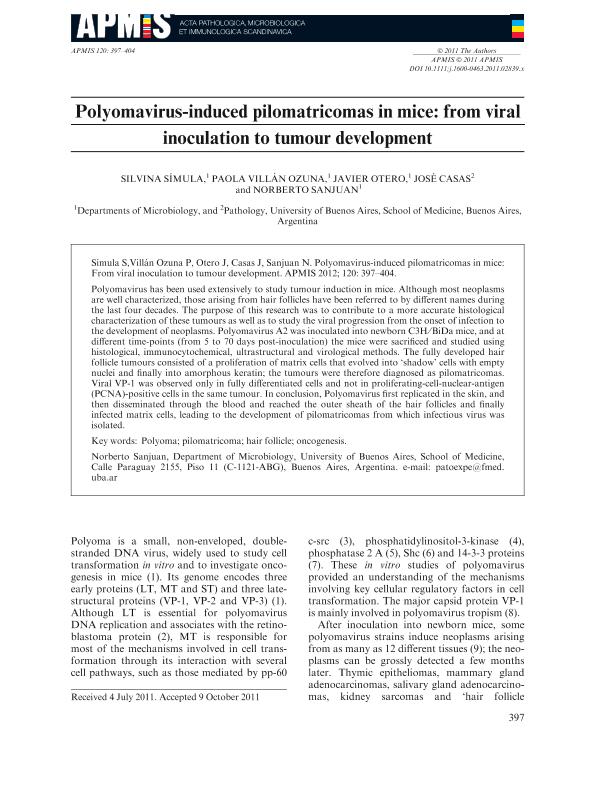Mostrar el registro sencillo del ítem
dc.contributor.author
Simula, Silvina

dc.contributor.author
Ozuna, Paola Villán
dc.contributor.author
Otero, Javier
dc.contributor.author
Casas, José
dc.contributor.author
Sanjuan, Norberto Aníbal

dc.date.available
2019-01-03T17:26:39Z
dc.date.issued
2012-05
dc.identifier.citation
Simula, Silvina; Ozuna, Paola Villán; Otero, Javier; Casas, José; Sanjuan, Norberto Aníbal; Polyomavirus-induced pilomatricomas in mice: From viral inoculation to tumour development; Wiley Blackwell Publishing, Inc; Apmis; 120; 5; 5-2012; 397-404
dc.identifier.issn
0903-4641
dc.identifier.uri
http://hdl.handle.net/11336/67299
dc.description.abstract
Polyomavirus has been used extensively to study tumour induction in mice. Although most neoplasms are well characterized, those arising from hair follicles have been referred to by different names during the last four decades. The purpose of this research was to contribute to a more accurate histological characterization of these tumours as well as to study the viral progression from the onset of infection to the development of neoplasms. Polyomavirus A2 was inoculated into newborn C3H/BiDa mice, and at different time-points (from 5 to 70days post-inoculation) the mice were sacrificed and studied using histological, immunocytochemical, ultrastructural and virological methods. The fully developed hair follicle tumours consisted of a proliferation of matrix cells that evolved into 'shadow' cells with empty nuclei and finally into amorphous keratin; the tumours were therefore diagnosed as pilomatricomas. Viral VP-1 was observed only in fully differentiated cells and not in proliferating-cell-nuclear-antigen (PCNA)-positive cells in the same tumour. In conclusion, Polyomavirus first replicated in the skin, and then disseminated through the blood and reached the outer sheath of the hair follicles and finally infected matrix cells, leading to the development of pilomatricomas from which infectious virus was isolated. © 2011 The Authors. APMIS © 2011 APMIS.
dc.format
application/pdf
dc.language.iso
eng
dc.publisher
Wiley Blackwell Publishing, Inc

dc.rights
info:eu-repo/semantics/openAccess
dc.rights.uri
https://creativecommons.org/licenses/by-nc-sa/2.5/ar/
dc.subject
Hair Follicle
dc.subject
Oncogenesis
dc.subject
Pilomatricoma
dc.subject
Polyoma
dc.subject.classification
Patología

dc.subject.classification
Medicina Básica

dc.subject.classification
CIENCIAS MÉDICAS Y DE LA SALUD

dc.title
Polyomavirus-induced pilomatricomas in mice: From viral inoculation to tumour development
dc.type
info:eu-repo/semantics/article
dc.type
info:ar-repo/semantics/artículo
dc.type
info:eu-repo/semantics/publishedVersion
dc.date.updated
2019-01-02T19:50:03Z
dc.journal.volume
120
dc.journal.number
5
dc.journal.pagination
397-404
dc.journal.pais
Reino Unido

dc.journal.ciudad
Londres
dc.description.fil
Fil: Simula, Silvina. Consejo Nacional de Investigaciones Científicas y Técnicas; Argentina. Universidad de Buenos Aires. Facultad de Medicina. Departamento de Microbiología; Argentina
dc.description.fil
Fil: Ozuna, Paola Villán. Universidad de Buenos Aires. Facultad de Medicina. Departamento de Microbiología; Argentina
dc.description.fil
Fil: Otero, Javier. Universidad de Buenos Aires. Facultad de Medicina. Departamento de Patología; Argentina
dc.description.fil
Fil: Casas, José. Universidad de Buenos Aires. Facultad de Medicina. Departamento de Microbiología; Argentina
dc.description.fil
Fil: Sanjuan, Norberto Aníbal. Consejo Nacional de Investigaciones Científicas y Técnicas; Argentina. Universidad de Buenos Aires. Facultad de Medicina. Departamento de Microbiología; Argentina
dc.journal.title
Apmis

dc.relation.alternativeid
info:eu-repo/semantics/altIdentifier/doi/https://dx.doi.org/10.1111/j.1600-0463.2011.02839.x
dc.relation.alternativeid
info:eu-repo/semantics/altIdentifier/url/https://onlinelibrary.wiley.com/doi/abs/10.1111/j.1600-0463.2011.02839.x
Archivos asociados
